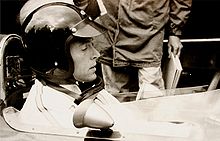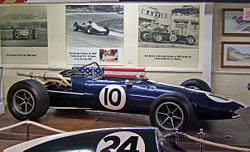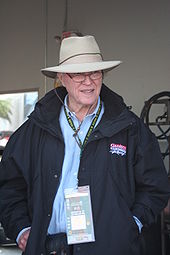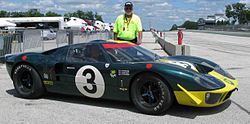- Dan Gurney
-
Dan Gurney 
Born April 13, 1931 Formula One World Championship career Nationality  American
AmericanActive years 1959 - 1968, 1970 Teams Ferrari, BRM, Porsche, Lotus, Brabham, Eagle, McLaren Races 87 (86 starts) Championships 0 Wins 4 Podiums 19 Career points 133 Pole positions 3 Fastest laps 6 First race 1959 French Grand Prix First win 1962 French Grand Prix Last win 1967 Belgian Grand Prix Last race 1970 British Grand Prix Daniel Sexton Gurney (born April 13, 1931) is an American racing driver, race car constructor, and team owner.
The son of a Metropolitan Opera star,[1] he was born in Port Jefferson, New York, but moved to California as a teenager. He has been a driver, a car manufacturer, and a team owner at racing's highest levels since 1958.
Gurney also won races in the Indy Car, NASCAR, Can-Am, and Trans-Am Series. Gurney was the first driver to win races in Sports Cars (1958), Formula One (1962), NASCAR (1963), and Indy Car (1967) (the other two being Mario Andretti and Juan Pablo Montoya). In 1967, after winning the 24 hours of Le Mans together with A.J. Foyt, he spontaneously sprayed champagne while celebrating on the podium. Apart from starting this tradition, he also was the first to put a simple right-angle extension on the upper trailing edge of the rear wing. This device, called a Gurney flap, increases downforce and, if well designed, imposes only a relatively small increase in aerodynamic drag. At the 1968 German Grand Prix he became the first driver ever to use a full face helmet in Grand Prix racing.[2]
Contents
Early life
Dan Gurney's father, John Gurney, was a prominent singer with the Metropolitan Opera in New York who retired in 1947 and moved the family to Riverside, California when Dan was a teenager. Young Dan quickly became caught up in the California hot rod culture. At age 19, he built and raced a car that went 138 miles per hour (mph) (222 kilometres per hour [km/h]) at the Bonneville Salt Flats. He then became an amateur drag racer and sports car racer. He served in the United States Army during the Korean War.[3]
Formula One Career
Driver
Gurney's first major break occurred in the fall of 1957, when he was invited to test a 4.9-litre Ferrari owned by Frank Arciero. This ill-handling brute of a car was very fast, but even top drivers like Carroll Shelby and Ken Miles had found it difficult to handle. He finished second in the inaugural Riverside Grand Prix (behind Shelby), beating established stars like Masten Gregory, Walt Hansgen and Phil Hill. This attracted the attention of famed Ferrari North American importer Luigi Chinetti, who arranged for a factory ride for the young driver at Le Mans in 1958. Gurney, teamed with fellow Californian Bruce Kessler, had worked the car up to fifth overall and handed over to Kessler, who was then caught up in an accident. This performance, and others, earned him a test run in a works Ferrari, and his Formula One career began with the team in 1959. In just four races that first year, he earned two podium finishes, but the team's strict management style did not suit him. In 1960 he had six non-finishes in seven races behind the wheel of a privately-entered BRM. At the Dutch Grand Prix, at Zandvoort, a brake system failure on the poorly-prepared BRM caused the most serious accident of his career, breaking his arm, killing a young spectator and instilling in him a longstanding distrust of engineers. The accident also caused him to make a change in his driving style that later paid dividends: his tendency to use his brakes more sparingly than his rivals meant that they lasted longer, especially in endurance races. Gurney was known to give the brake pedal a reassuring tap just before hard application — a habit Gurney himself jokingly referred to as "the chicken-sh*t school of braking."
Gurney was particularly noted for an exceptionally fluid driving style. On rare occasions, as when his car fell behind with minor mechanical troubles and he felt he had nothing to lose, he would abandon his classic technique and adopt a more aggressive (and riskier) style. This circumstance produced what many observers consider the finest driving performance of his career, when a punctured tyre put him nearly two laps down halfway through the 1967 Rex Mays 300 Indycar race at Riverside, California. He produced an inspired effort, made up the deficit and won the race with a dramatic last-lap pass of runner-up Bobby Unser.
After rules changes came in effect in 1961, he teamed with Jo Bonnier for the first full season of the factory Porsche team, scoring three second places. He came very close to scoring a maiden victory at Reims, France in 1961, but Gurney's reluctance to block Ferrari driver Giancarlo Baghetti (a move Gurney regarded as dangerous and unsportsmanlike) allowed Baghetti to pass him on the finish line for the win. After Porsche introduced a better car in 1962 with an 8-cylinder engine, Gurney broke through at the French Grand Prix at Rouen-Les-Essarts with his first World Championship victory - the only GP win for Porsche as an F1 constructor. One week later, he repeated the success in a non-Championship F1 race in front of Porsche's home crowd at Stuttgart's Solitude race track. Due to the high costs of racing in F1, Porsche did not continue after the 1962 season. While with Porsche, Gurney met a team public relations executive named Evi Butz, and they married several years later.
Gurney was the first driver hired by Jack Brabham to drive with him for the Brabham Racing Organisation. While Brabham himself scored the maiden victory for his car at the 1963 Solitude race, it was Gurney again who took the team's first win in a championship race, in 1964, again at Rouen. In all, he earned two wins (in 1964) and ten podiums (including five consecutive in 1965) for Brabham before leaving to start his own team. With his victory in the Eagle-Weslake at the 1967 Belgian Grand Prix, Gurney earned the distinction of being the only driver to score maiden Grand Prix victories for three different manufacturers: Porsche, Brabham and, his own, All-American Racers.
Gurney developed a new kind of motorcycle called "Alligator",[4] which featured an extremely low seat position.
Gurney's unusual height for a race driver caused him constant problems during his career. During the 1.5-litre era of Formula 1, Gurney's head and shoulders extended high into the windstream compared to his shorter competitors, giving him (he felt) an aerodynamic disadvantage in the tiny, underpowered cars. At nearly 6'3", Gurney struggled to fit into the tight Ford GT40 cockpit, so master fabricator Phil Remington installed a roof bubble over the driver's seat to allow space for Gurney's helmet - now known as a "Gurney bubble". In a fortunate error, the Italian coachbuilder that built the body for the 1964 Le Mans class-winning closed-cockpit Cobra Daytona GT coupe driven by Gurney and Bob Bondurant mistakenly made the cockpit "greenhouse" two inches too tall — the only thing that permitted Gurney to fit in the car comfortably.[5]
Manufacturer
 An Eagle T2G, the USAC variant of the first Eagle chassis. Almost identical to its Formula One sister model the T1G.
An Eagle T2G, the USAC variant of the first Eagle chassis. Almost identical to its Formula One sister model the T1G.
In 1962, Gurney and Carroll Shelby began dreaming of building an American racing car to compete with the best European makes. Shelby convinced Goodyear, who wanted to challenge Firestone's domination of American racing at the time, to sponsor the team. Goodyear's president Victor Holt (himself a former college All-American basketball player) suggested the name, "All American Racers", and the team was formed in 1965. Gurney was not comfortable with the name at first, fearing it sounded somewhat jingoistic, but felt compelled to agree to his benefactor's suggestion.[citation needed]
Their initial focus was Indianapolis and Goodyear's battle with Firestone, but Gurney's first love was road racing, especially in Europe, and he wanted to win the Formula One World Championship while driving an American Grand Prix 'Eagle'. Partnered with British engine maker Weslake, the Formula One effort was called "Anglo American Racers." The Weslake V12 engine was not ready for the 1966 Grand Prix season, so the team used outdated four-cylinder 2.7-litre Coventry-Climax engines and made their first appearance in the second race of the year in Belgium. This was the race of the sudden torrential downpour captured in the feature film Grand Prix, and although Gurney completed the race in seventh place, he was judged too far back to be classified as a finisher. Gurney scored the team's first Championship points three weeks later by finishing fifth in the French Grand Prix at Reims.
The next season the team failed to finish any of the first three races, but on June 18, 1967, Gurney took a historic victory in the Belgian Grand Prix. Starting in the middle of the first row, Gurney initially followed Jim Clark's Lotus and the BRM of Jackie Stewart. A muffed start left Gurney deep in the field at the end of the first lap. Clark encountered problems on Lap 12 that dropped him down to ninth position. Having moved up to second spot, Gurney set the fastest lap of the race on Lap 19. Two laps later he and his Eagle took the lead and came home over a minute ahead of Stewart.
This win came just a week after his surprise victory with A.J. Foyt at 24 hours of Le Mans, where Gurney spontaneously began the now-familiar winner's tradition of spraying champagne from the podium to celebrate the unexpected win against the Ferraris and the other Ford GT40 teams. Gurney said later that he took great satisfaction in proving wrong the critics (including some members of the Ford team) who predicted the two great drivers, normally rivals, would break their car in an effort to show each other up.
Unfortunately, the victory in Belgium was the high point for AAR as engine problems continued to plague the Eagle. Despite the antiquated engine tooling used by the Weslake factory (dating from World War I), failures rarely stemmed from the engine design itself, but more often from unreliable peripheral systems like fuel pumps, fuel injection and the oil delivery system. He led the 1967 German Grand Prix at the Nürburgring when a driveshaft failed two laps from the end with a 42-second lead in hand. After a third-place finish in Canada that year, the car would finish only one more race. By the end of the 1968 season, Gurney was driving a McLaren-Ford. His last Formula One race was the 1970 British Grand Prix.
Formula One results
Complete Formula One World Championship results
(key) (Races in bold indicate pole position; races in italics indicate fastest lap)
Non-Championship results
1959-1960 to be completed (key) (Races in bold indicate pole position) (Races in italics indicate fastest lap)
Year Entrant Chassis Engine 1 2 3 4 5 6 7 8 9 10 11 12 13 14 15 16 17 18 19 20 21 1961 Porsche System Engineering Porsche 804 Porsche F4 LOM GLV PAU BRX
RetVIE SYR
2NAP LON SOL
3KAN DAN MOD
3FLG OUL
WDLEW VAL RAN NAT RSA Louise Bryden-Brown Lotus 18 Coventry Climax L4 AIN
14SIL
51962 Porsche System Engineering Porsche 804 Porsche F4 CAP BRX LOM LAV GLV PAU AIN INT NAP MAL CLP RMS SOL
1KAN MED DAN OUL MEX
DNARAN NAT 1963 Brabham Racing Organisation Brabham BT7 Coventry Climax V8 LOM GLV PAU IMO SYR AIN INT
WDROM SOL KAN
WDMED AUT OUL
RetRAN 1964 Brabham Racing Organisation Brabham BT7 Coventry Climax V8 DMT NWT SYR AIN
RetINT
RetSOL
WDMED RAN 1965 Brabham Racing Organisation Brabham BT11 Coventry Climax V8 ROC
RetSYR SMT
9INT MED RAN 1967 Anglo American Racers Eagle Mk1 Weslake V12 ROC
1SPC INT SYR OUL ESP Legacy
Among American drivers, his 86 Grand Prix starts ranks third, and his total of four GP wins is second only to Mario Andretti. Perhaps the greatest tribute to Gurney's driving ability, however, was paid by the father of Scottish World Champion Jim Clark when the elder Clark took Gurney aside at his son's funeral in 1968 and confided that he was the only driver Clark had ever feared on the track. (Horton, 1999).
The 2010 Monterey Motorsports Reunion (formerly the Monterey Historic Automobile Races) was held in honor of Gurney.[6]
American Championship Car
While competing in Formula One, Gurney also raced each year in the Indianapolis 500 from 1962-1970. Gurney made his Indy début at the wheel of a space-frame rear engined car designed by John Crosthwaite and built by American hot-rodder Mickey Thompson[7] [8] [9] [10] [11] The last 3 years, he finished 2nd, 2nd, and 3rd, respectively. In 1969, he did not race in Formula One, instead racing in the USAC Championship Car series and also in CanAm. He started a total of 28 Champ Car races, winning 7 times among his 18 top tens. In 1969, he finished 4th in total points, despite starting half the races of most top drivers (and would have finished second in the season standings to champion Mario Andretti if not for a driveshaft failure while leading comfortably with three laps remaining in the season finale at Riverside). In 1968, he finished 7th with only 5 starts.
Indy 500 results
Year Chassis Engine Start Finish 1962 Thompson Buick 8th 20th 1963 Lotus Ford 12th 7th 1964 Lotus Ford 6th 17th 1965 Lotus Ford 3rd 26th 1966 Eagle Ford 19th 27th 1967 Eagle Ford 2nd 21st 1968 Eagle Ford 10th 2nd 1969 Eagle Ford 10th 2nd 1970 Eagle Offy 11th 3rd NASCAR career
Dan Gurney 
Gurney's 1963 Riverside 500 car.Born  Port Jefferson, New York
Port Jefferson, New YorkNASCAR Sprint Cup Series career 16 races run over 10 years Best finish Unranked First race 1962 Daytona Qualifier#1 (Daytona) Last race 1980 Winston Western 500 (Riverside) First win 1963 Riverside 500 (Riverside) Last win 1968 Motor Trend 500 (Riverside) Wins Top tens Poles 5 8 10 Gurney's first career start was in 1962. Gurney was nearly unbeatable in a NASCAR Grand National car at Riverside International Raceway in Riverside, California. Four of his five victories came with the famed Wood Brothers, in 1964, 1965, 1966 and 1968, in cars all numbered 121 (a simple graphic addition to the team's traditional "21"). The serial success of the Gurney/Wood Brothers combination did not sit well with NASCAR officials, so in 1967 Gurney signed to drive a Mercury Comet for legendary NASCAR crew chief Bud Moore. However, the 1967 Motor Trend 500 was won by Gurney's teammate, Parnelli Jones, after Gurney retired with engine troubles. Gurney also made numerous appearances in NASCAR Grand American stockcars, a pony car division that existed between 1968 and 1971.
At about the time Gurney began making occasional appearances in stock cars in the United States, Dan took a Chevrolet Impala to England and entered it in several "saloon car" (stock car) races. In a race at Silverstone in 1962, he led Jaguar drivers handily until a wheel broke. When he returned with the same car for a race three months later, technical inspectors disallowed his entry.
In 1980, Gurney came out of a 10-year retirement to help old friend Les Richter, the president of Riverside. (Gurney's adoption of the number that became most closely identified with his career, 48, was a nod to Richter's NFL number.) Dan agreed to drive a second Rod Osterlund Chevrolet for one NASCAR race as teammate to a rising young star named Dale Earnhardt. As a condition of allowing Gurney to drive in the race after a 10-year layoff, Richter insisted that Gurney attend the racing school run by former teammate and friend Bob Bondurant. After Gurney's refresher session, Richter called Bondurant and asked how Gurney had done. "He didn't need a refresher," Bondurant reportedly told Richter. "He was faster than me then, and he still is." Ticket sales surged upon the announcement of Gurney's return. In a car painted blue and white and carrying his famed number 48, Dan easily ran with the leaders. Displaying his usual fluid style, Dan was running third when the transmission let go.
Full-time team owner
Gurney and his protege Swede Savage drove identical factory-sponsored Plymouth Barracudas in the 1970 Trans-Am Series. Upon his retirement from Formula One, Gurney devoted himself full-time to his role as car maker and team owner. He was the sole owner, Chairman and CEO of All American Racers from 1970 until his son, Justin, assumed the title of CEO in early 2011.[12] The team won 78 races (including the Indianapolis 500, the 12 Hours of Sebring, and the 24 Hours of Daytona) and eight championships, while Gurney's Eagle race car customers also won three Indianapolis 500 races and three championships. In 1978, Gurney wrote an open memo to other race car owners with what is now known as the "White Letter" in which Gurney called for a series controlled more by the owners or "actual participants" than under the USAC banner. After much debate, CART was formed with Gurney and other owners like Roger Penske, Pat Patrick, and Bob Fletcher. CART began its first full season of competition in March, 1979 and thus the first split in open wheel racing began.
AAR withdrew from the CART series in 1986, but enjoyed tremendous success with Toyota in the IMSA GTP series, where in 1992 and 1993 Toyota Eagles won 17 consecutive races, back-to-back Drivers' and Manufacturers' Championships, and wins in the endurance classics of Daytona and Sebring. The team returned to CART as the factory Toyota team in 1996, but left again after the 1999 season when Goodyear withdrew from the series and Toyota ended their relationship with the team. In 2000, Dan campaigned a Toyota Atlantic car for his son, Alex Gurney under the AAR banner.
In 1990, Gurney was inducted into the International Motorsports Hall of Fame. He is also a member of the Motorsports Hall of Fame of America, the Sebring International Raceway Hall of Fame, and the West Coast Stock Car Hall of Fame.
See also
- Riverside International Automotive Museum
References
- ^ All American Racers bio
- ^ http://www.allamericanracers.com/gurney_grand-prix/eagle_f1-photo.html
- ^ Biography at the West Coast Stock Car Hall of Fame, 2003, Retrieved November 8, 2007
- ^ Alligator homepage
- ^ Road & Track July 2005. On the Road: Fast friends and fast cars.
- ^ http://www.mazdaraceway.com/pages/2010_Rolex_Monterey_Motorsports_Reunion
- ^ Car and Driver magazine August 1962
- ^ Hot Rod magazine August 1962
- ^ Motor magazine August 1962
- ^ Indianapolis 500 Mile Race USAC Yearbook 1962. Floyd Clymer
- ^ Road & Track magazine September 1962
- ^ "Dan Gurney talks about the new DeltaWing". AutoWeek. http://www.autoweek.com/article/20110628/ALMS/110629868. Retrieved 9 July 2011.
- Eagle-eye. Dan Gurney's All American Racers.
- Dan Gurney. GP Encyclopedia. The Motorsport Company.
- Blinkhorn, Robert. Dan Gurney. Grand Prix Racing—The Whole Story.
- David, Dennis. Dan Gurney. Grand Prix History.
- Horton, Roger (1999). Remember Jim Clark. Atlas Formula One Journal.
- The Gurney Flap.All American Racers - Gurney Flap.
- The Greatest 33
- Gurney's Career NASCAR Starts
External links
Sporting positions Preceded by
Mike SpenceBrands Hatch Race of Champions winner
1967Succeeded by
Bruce McLarenPreceded by
Bruce McLaren
Chris AmonWinner of the 24 Hours of Le Mans
1967 with:
A. J. FoytSucceeded by
Pedro Rodriguez
Lucien Bianchi3/6/24 hrs + 2000km winners at Daytona Five-time Four-time Three-time Two-time Mauro Baldi · Terry Borcheller · Elliott Forbes-Robinson · A. J. Foyt · Al Holbert · Jan Lammers · Ken Miles · Juan Pablo Montoya · John Paul, Jr. · Memo Rojas · Lloyd Ruby · Wayne Taylor · Didier Theys · Al Unser, Jr.
One-time Amon · J. Andretti · Ma. Andretti · Angelelli · Ballot-Léna · Bandini · Barber · Barbosa · Beretta · Bergmeister · Bernhard · Boesel · Bouchut · Boutsen · Brundle · Buckler · Collard · Dalziel · Dismore · Dixon · D. Donohue · M. Donohue · Dupuy · Durán · Duxbury · Dyson · Elford · Fellows · Field · Fittipaldi · Fitzpatrick · Franchitti · Fréon · García · Garretson · Gentilozzi · Graves · Gurney · Hand · Hasemi · Helmick · Henn · Herrmann · Hezemans · Hill · Hoshino · Ickx · Jelinski · Joest · D. Jones · P. Jones · Kinnunen · Kneifel · Krages · Lässig · Lavaggi · Law · Lienhard · Luyendyk · Martin · Mears · Merl · Millen · Moran · Moretti · Neerpasch · Nielsen · O'Connell · Oliver · Ongais · Pace · Papis · Parsons · Paul, Sr. · Pescarolo · Pilgrim · B. Rahal · G. Rahal · Rice · Robinson · Rockenfeller · Schneider · Schrom · Sharp · Siffert · Suzuki · Unser, Sr. · van der Merwe · Weaver · Wendlinger · Werner · Wheldon
12 Hours of Sebring winners Five-time Four-time Three-time Two-time Bob Akin · Geoff Brabham · Derek Daly · Andy Evans · Juan Manuel Fangio · Juan Manuel Fangio II · Olivier Gendebien · Hurley Haywood · Hans Herrmann · Phil Hill · Al Holbert · Jacky Ickx · Stefan Johansson · JJ Lehto · Emanuele Pirro · Brian Redman · Hans-Joachim Stuck · Eric van de Poele · Fermín Vélez · Andy Wallace · Phil Walters
One-time Aïello · Alboreto · Baker · Baldi · Barbour · Behra · Bernhard · Bianchi · Bonnier · Gary Brabham · Castellotti · Collard · Collins · Daigh · Dalmas · Davidson · de Narvaez · Dumas · Duval · Dyer · Earl · Elford · Fitch · Fitzpatrick · Foyt · Frisselle · Garretson · Gartner · Gené · Giunti · Gray · Gregg · Gurney · Hall · Hawthorn · Helmick · Herbert · Heyer · Kaffer · Keyser · Kulok · Lapierre · Larrousse · Leven · Lloyd · Ludwig · Luyendyk · Maglioli · Mass · McFarlin · McLaren · Mendez · Miles · Millen · Moffat · Moretti · Morton · Moss · Mullen · Müller · Nierop · O'Connell · Oliver · Pace · Panis · Parkes · Paul, Jr. · Paul, Sr. · Pescatori · Peter · Rahal · Robinson · Ruby · Scarfiotti · Sharp · Siffert · Surtees · Taylor · Theys · Vaccarella · Wollek · Woods · Wurz
Categories:- 1931 births
- 24 Hours of Le Mans drivers
- American Formula One drivers
- American racecar drivers
- British Touring Car Championship drivers
- Ferrari Formula One drivers
- Formula One drivers and team owners
- Indianapolis 500 drivers
- International Motorsports Hall of Fame inductees
- Living people
- McLaren Formula One drivers
- NASCAR drivers
- People from Riverside, California
- Racecar drivers from California
- Sportspeople from California
- Trans-Am drivers
- Wood Brothers Racing drivers
Wikimedia Foundation. 2010.


